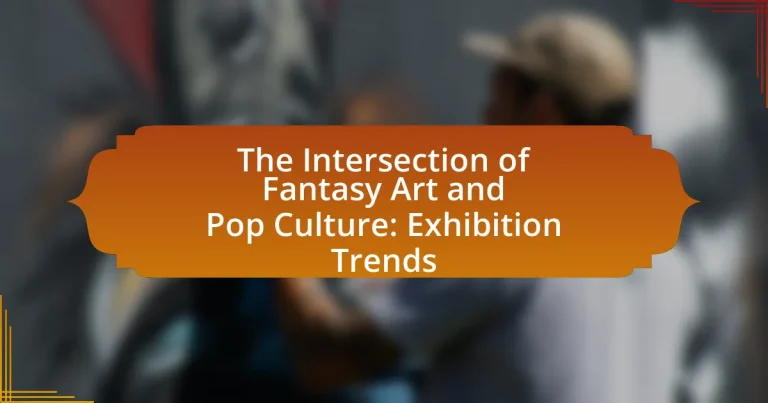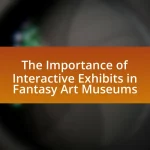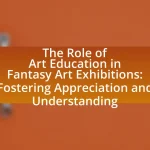The article examines the intersection of fantasy art and pop culture, highlighting how imaginative visual styles from fantasy genres are integrated into mainstream media, including films, video games, and merchandise. It explores the reciprocal influence between fantasy art and pop culture, historical connections, and the impact of technology on this relationship. Current trends in fantasy art exhibitions, including immersive experiences and the use of digital platforms, are discussed, along with the significance of these exhibitions in promoting diversity and engaging audiences. The article also addresses the challenges faced by curators and offers practical tips for successful exhibitions, emphasizing the importance of effective marketing strategies and audience engagement.
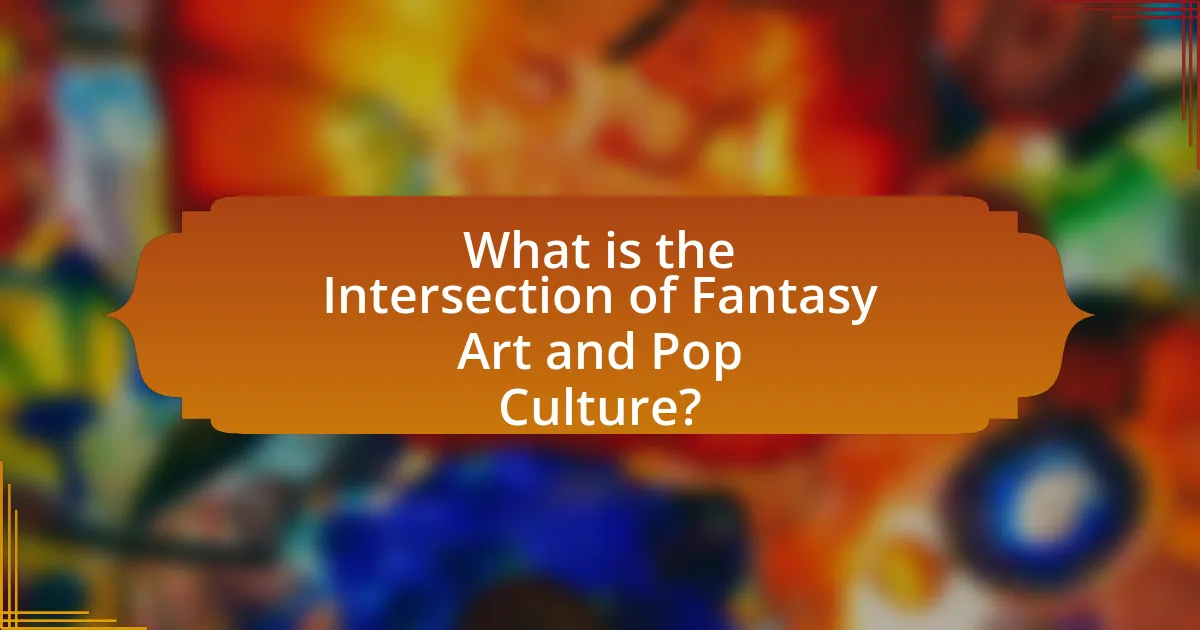
What is the Intersection of Fantasy Art and Pop Culture?
The intersection of fantasy art and pop culture is characterized by the integration of imaginative visual styles and themes from fantasy genres into mainstream media, including films, video games, and merchandise. This convergence is evident in the popularity of franchises like “The Lord of the Rings” and “Game of Thrones,” which have influenced visual aesthetics in various forms of entertainment. Additionally, fantasy art is showcased in conventions and exhibitions, such as Comic-Con, where artists and fans celebrate the genre, further solidifying its presence in pop culture. The rise of digital platforms has also enabled artists to reach wider audiences, making fantasy art a significant component of contemporary cultural expression.
How do fantasy art and pop culture influence each other?
Fantasy art and pop culture influence each other through a reciprocal relationship where fantasy art shapes visual aesthetics in pop culture, while pop culture provides themes and narratives that inspire fantasy art. For instance, the rise of fantasy films, such as “The Lord of the Rings,” has led to an increase in fantasy-themed artwork, as artists seek to capture the visual elements and storytelling techniques popularized by these films. Conversely, iconic fantasy art, like that of Frank Frazetta, has influenced the design of characters and worlds in video games and movies, demonstrating how established art styles can permeate mainstream media. This interplay is evident in merchandise, fan art, and conventions, where both realms continuously draw from and enrich one another, creating a dynamic cultural exchange.
What are the historical connections between fantasy art and pop culture?
Fantasy art has historically influenced pop culture through its integration into various media, including literature, film, and gaming. The emergence of fantasy art in the 19th century, exemplified by artists like Arthur Rackham and Gustave Doré, laid the groundwork for visual storytelling that permeated popular narratives. This connection intensified in the 20th century with the rise of fantasy literature, notably J.R.R. Tolkien’s “The Lord of the Rings,” which inspired a wave of visual adaptations and merchandise, solidifying fantasy art’s role in shaping pop culture. Additionally, the proliferation of role-playing games in the 1970s, such as Dungeons & Dragons, further entrenched fantasy art in mainstream culture, leading to a symbiotic relationship where visual art and pop culture continuously influence each other. This historical trajectory illustrates how fantasy art has not only reflected but also shaped the evolving landscape of pop culture.
How has the evolution of technology impacted this intersection?
The evolution of technology has significantly transformed the intersection of fantasy art and pop culture by enhancing accessibility and engagement. Digital platforms enable artists to showcase their work globally, allowing for a broader audience reach and interaction through social media and online galleries. For instance, the rise of virtual reality (VR) and augmented reality (AR) technologies has created immersive experiences in exhibitions, allowing viewers to engage with fantasy art in innovative ways. According to a report by the International Council of Museums, 70% of museums have adopted digital technologies to enhance visitor experiences, demonstrating the impact of technology on exhibition trends in this genre.
Why is the intersection of fantasy art and pop culture significant?
The intersection of fantasy art and pop culture is significant because it reflects and shapes societal values, trends, and collective imagination. This convergence allows for the exploration of themes such as heroism, identity, and escapism, which resonate deeply with audiences. For instance, the popularity of franchises like “Star Wars” and “Harry Potter” demonstrates how fantasy art influences mainstream media, driving merchandise sales and fan engagement. Additionally, events like Comic-Con highlight the cultural impact of fantasy art, showcasing its role in community building and creative expression. This significance is further evidenced by the increasing presence of fantasy art in galleries and exhibitions, indicating its acceptance and importance in contemporary art discourse.
What cultural movements have emerged from this intersection?
The intersection of fantasy art and pop culture has given rise to several cultural movements, notably the rise of fan art communities, the popularity of cosplay, and the emergence of digital art as a mainstream medium. Fan art communities have flourished online, allowing artists to reinterpret and create works based on popular franchises, which has led to a democratization of art and increased visibility for independent creators. Cosplay, where fans dress as characters from fantasy and pop culture, has become a significant cultural phenomenon, celebrated at conventions and social media platforms, fostering a sense of community and creativity among participants. Additionally, digital art has gained prominence, with platforms like DeviantArt and ArtStation showcasing artists who blend traditional fantasy themes with contemporary pop culture elements, reflecting the evolving landscape of artistic expression. These movements illustrate the dynamic relationship between fantasy art and pop culture, highlighting their influence on contemporary artistic practices.
How does this intersection reflect societal values and trends?
The intersection of fantasy art and pop culture reflects contemporary societal values and trends by showcasing the increasing acceptance and celebration of diverse narratives and identities. This phenomenon is evidenced by the rise of fantasy art exhibitions that feature works from artists of various backgrounds, emphasizing inclusivity and representation. For instance, events like the “Spectrum Fantastic Art Live” have highlighted the importance of diverse voices in fantasy art, aligning with broader societal movements advocating for equality and representation in media. Additionally, the popularity of fantasy franchises, such as “Game of Thrones” and “The Witcher,” illustrates a cultural shift towards escapism and the exploration of complex moral themes, mirroring societal interests in nuanced storytelling and character development.
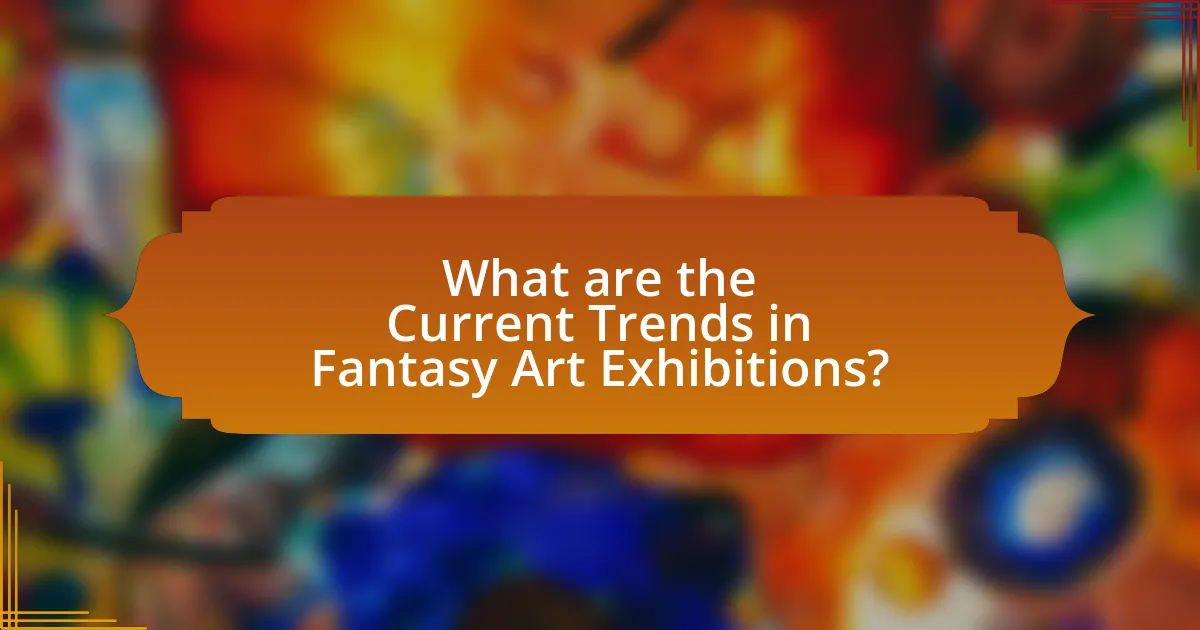
What are the Current Trends in Fantasy Art Exhibitions?
Current trends in fantasy art exhibitions include a focus on immersive experiences, the integration of technology, and collaborations with popular media franchises. Immersive experiences, such as virtual reality installations and interactive displays, engage audiences more deeply, allowing them to step into fantastical worlds. The use of augmented reality and digital art is increasingly prevalent, enhancing traditional artworks and creating dynamic environments. Collaborations with franchises like video games, films, and literature are also on the rise, as they attract larger audiences and create cross-promotional opportunities. For instance, exhibitions featuring artwork from popular series like “Game of Thrones” or “The Lord of the Rings” have drawn significant attendance, demonstrating the effective merging of fantasy art with mainstream pop culture.
How are contemporary artists showcasing fantasy art in pop culture?
Contemporary artists are showcasing fantasy art in pop culture through various mediums such as digital art, illustration, and immersive installations. These artists often collaborate with popular franchises in film, video games, and literature, creating visually striking works that resonate with mainstream audiences. For instance, artists like Yoshitaka Amano and Brian Froud have contributed to iconic fantasy films, while digital platforms like Instagram and online galleries allow artists to reach wider audiences, promoting their fantasy-themed artworks. Additionally, events like Comic-Con and art exhibitions dedicated to fantasy themes further highlight the integration of fantasy art into pop culture, demonstrating its growing significance and appeal.
What mediums are most popular in current fantasy art exhibitions?
Digital art and illustration are the most popular mediums in current fantasy art exhibitions. This trend reflects the increasing integration of technology in artistic expression, with artists utilizing software and digital tools to create immersive and visually striking works. According to a report by Art Basel, digital art sales have surged, indicating a growing acceptance and demand for this medium in the art world. Additionally, traditional mediums such as painting and sculpture remain relevant, but they are often complemented by digital elements, showcasing a hybrid approach that resonates with contemporary audiences.
How do themes in fantasy art reflect current pop culture phenomena?
Themes in fantasy art reflect current pop culture phenomena by incorporating contemporary societal issues, popular media narratives, and technological advancements. For instance, fantasy art often depicts characters and scenarios inspired by blockbuster films, video games, and streaming series, showcasing elements like superheroes or dystopian futures that resonate with audiences today. Additionally, artists frequently address themes such as diversity and environmentalism, mirroring ongoing discussions in society. This alignment with pop culture is evident in exhibitions that feature works inspired by franchises like “Game of Thrones” or “The Witcher,” which have gained immense popularity and shaped public discourse. Thus, fantasy art serves as a visual commentary on the zeitgeist, making it relevant and reflective of current cultural dynamics.
What role do exhibitions play in promoting fantasy art?
Exhibitions play a crucial role in promoting fantasy art by providing a platform for artists to showcase their work to a broader audience. These events facilitate direct engagement between artists and fans, allowing for the exchange of ideas and appreciation of the genre. For instance, major exhibitions like the “Spectrum Fantastic Art Live” have attracted thousands of attendees, highlighting the growing interest in fantasy art and its integration into mainstream culture. Additionally, exhibitions often feature workshops and panels that educate attendees about the techniques and narratives behind fantasy art, further enhancing its visibility and appreciation within the art community.
How do exhibitions engage audiences with fantasy art?
Exhibitions engage audiences with fantasy art by creating immersive experiences that stimulate imagination and emotional connection. These exhibitions often utilize interactive displays, themed environments, and multimedia presentations to draw visitors into the fantastical worlds depicted in the artwork. For instance, the “Fantasy Art Exhibition” at the Museum of Pop Culture in Seattle featured life-sized replicas of iconic fantasy settings, allowing attendees to step into the art and experience it firsthand. This approach not only enhances viewer engagement but also fosters a deeper appreciation for the artistry and storytelling inherent in fantasy art.
What are the challenges faced by curators in fantasy art exhibitions?
Curators in fantasy art exhibitions face several challenges, including the difficulty of sourcing diverse and high-quality artworks that accurately represent the genre. This challenge is compounded by the need to balance commercial interests with artistic integrity, as many fantasy artworks are tied to popular media franchises. Additionally, curators must navigate the complexities of copyright and licensing issues, particularly when displaying works inspired by established intellectual properties. The challenge of engaging a broad audience while maintaining the niche appeal of fantasy art further complicates exhibition planning. According to a study by the Museum of Pop Culture, curators often report that audience expectations can clash with the artistic vision, making it essential to find innovative ways to present fantasy art that resonates with both enthusiasts and newcomers.

How is Technology Shaping Fantasy Art and Pop Culture Exhibitions?
Technology is significantly shaping fantasy art and pop culture exhibitions by enhancing interactivity and accessibility. Innovations such as virtual reality (VR) and augmented reality (AR) allow visitors to engage with artworks in immersive environments, creating a more dynamic experience. For instance, exhibitions like “The VR Experience” at the Museum of Modern Art have utilized VR to transport audiences into fantastical worlds, thereby increasing visitor engagement and interest. Additionally, digital platforms enable artists to showcase their work globally, reaching wider audiences beyond physical exhibition spaces. This shift is evidenced by the rise of online galleries and virtual exhibitions during events like the COVID-19 pandemic, which maintained audience interaction and participation. Overall, technology is transforming how fantasy art and pop culture are experienced, making exhibitions more interactive and accessible to diverse audiences.
What technological innovations are being used in fantasy art exhibitions?
Technological innovations in fantasy art exhibitions include virtual reality (VR), augmented reality (AR), and interactive installations. VR allows viewers to immerse themselves in fantastical worlds, enhancing the experience by enabling them to explore environments and interact with characters. AR overlays digital elements onto the physical space, creating a blended experience that engages audiences in new ways. Interactive installations often incorporate sensors and responsive technology, allowing visitors to influence the artwork through their actions. These innovations have been increasingly adopted in exhibitions, as evidenced by events like the “Fantasy Art in the Digital Age” exhibition, which showcased how technology can transform viewer engagement and artistic expression.
How do virtual and augmented reality enhance the exhibition experience?
Virtual and augmented reality enhance the exhibition experience by providing immersive and interactive environments that engage visitors more deeply than traditional displays. These technologies allow attendees to explore art and artifacts in a three-dimensional space, facilitating a more personal connection with the content. For instance, augmented reality can overlay digital information onto physical exhibits, enriching the narrative and context of the artwork. Research indicates that exhibitions utilizing virtual reality can increase visitor retention and satisfaction, as participants are more likely to remember experiences that involve active participation rather than passive observation.
What impact does social media have on the visibility of fantasy art exhibitions?
Social media significantly enhances the visibility of fantasy art exhibitions by providing a platform for artists and galleries to reach a broader audience. Through platforms like Instagram and Facebook, artists can showcase their work to millions, facilitating engagement and interaction with potential attendees. A study by the Pew Research Center indicates that 69% of adults in the U.S. use social media, which amplifies the promotional efforts of exhibitions. Additionally, hashtags and shares can create viral marketing effects, increasing attendance and interest in fantasy art events.
How can artists and curators leverage technology for better engagement?
Artists and curators can leverage technology for better engagement by utilizing digital platforms and interactive tools to enhance audience experiences. For instance, virtual reality (VR) and augmented reality (AR) can create immersive environments that allow viewers to interact with art in innovative ways, increasing emotional connection and understanding. A study by the National Endowment for the Arts found that 60% of participants reported a deeper appreciation for art when engaging through digital means. Additionally, social media platforms enable artists and curators to reach wider audiences, facilitating real-time feedback and community building. This approach not only broadens visibility but also fosters dialogue between creators and audiences, enhancing overall engagement.
What are best practices for integrating technology into exhibitions?
Best practices for integrating technology into exhibitions include utilizing interactive displays, incorporating augmented reality (AR), and employing digital signage. Interactive displays engage visitors by allowing them to participate in the exhibition, enhancing their experience and retention of information. For instance, museums that have implemented touchscreens or motion sensors report increased visitor interaction and satisfaction. Augmented reality can bring static exhibits to life, providing immersive experiences that deepen understanding; studies show that AR can increase visitor engagement by up to 30%. Digital signage offers real-time updates and information, improving navigation and accessibility within the exhibition space. These practices not only modernize the exhibition experience but also align with current trends in audience engagement and technology use in cultural spaces.
How can technology help in reaching wider audiences for fantasy art?
Technology can help in reaching wider audiences for fantasy art by utilizing digital platforms and social media to showcase artwork globally. Online galleries, social media channels, and virtual exhibitions enable artists to present their work to diverse audiences without geographical limitations. For instance, platforms like Instagram and Pinterest have millions of users, allowing artists to gain visibility and connect with fans and collectors worldwide. Additionally, technologies such as augmented reality (AR) and virtual reality (VR) create immersive experiences that engage viewers more deeply, enhancing their appreciation for fantasy art. According to a report by Statista, the global digital art market is projected to reach $2.6 billion by 2026, indicating a growing interest and potential for artists to reach larger audiences through technology.
What are the Future Directions for Fantasy Art and Pop Culture Exhibitions?
Future directions for fantasy art and pop culture exhibitions include increased integration of technology, such as virtual reality and augmented reality experiences, to enhance visitor engagement. These technologies allow audiences to immerse themselves in fantastical worlds, creating interactive environments that traditional exhibitions cannot offer. For instance, exhibitions like “The Art of Video Games” have successfully utilized multimedia elements to attract diverse audiences, demonstrating the effectiveness of this approach. Additionally, there is a growing trend towards inclusivity and representation, showcasing a wider range of artists and narratives that reflect diverse cultures and perspectives within the fantasy genre. This shift is supported by initiatives from organizations like the Comic Arts Brooklyn festival, which emphasizes diverse voices in comic and fantasy art.
What emerging trends should artists and curators be aware of?
Artists and curators should be aware of the increasing integration of digital technology in exhibitions, particularly through virtual and augmented reality experiences. This trend allows for immersive storytelling and interactive engagement, enhancing audience participation. According to a 2022 report by the International Council of Museums, 70% of museums are investing in digital technologies to create more dynamic and accessible exhibitions. Additionally, the rise of social media platforms as exhibition spaces is reshaping how art is shared and experienced, with artists leveraging these platforms to reach wider audiences and engage in real-time dialogue.
How can collaboration between artists and pop culture entities evolve?
Collaboration between artists and pop culture entities can evolve through the integration of technology and cross-disciplinary projects. As artists increasingly utilize digital platforms and social media, they can reach wider audiences and engage with pop culture entities in innovative ways, such as virtual reality experiences or interactive installations. For instance, the rise of NFTs (non-fungible tokens) has allowed artists to collaborate with brands and entertainment franchises, creating unique digital art that resonates with fans. This evolution is supported by the growing trend of immersive exhibitions, where art and pop culture converge, exemplified by events like the “Immersive Van Gogh” exhibit, which combines classic art with modern technology to attract diverse audiences.
What practical tips can artists and curators follow for successful exhibitions?
Artists and curators can ensure successful exhibitions by focusing on clear themes, effective marketing, and audience engagement. Establishing a cohesive theme helps to create a narrative that resonates with viewers, making the exhibition more memorable. For instance, exhibitions that center around specific aspects of pop culture or fantasy art can attract targeted audiences, as seen in the success of events like Comic-Con, which draws thousands due to its focused themes.
Effective marketing strategies, including social media promotion and partnerships with influencers in the fantasy and pop culture sectors, can significantly increase visibility and attendance. Research indicates that exhibitions with strong online presence see up to 30% higher visitor numbers compared to those without.
Engaging the audience through interactive elements, such as workshops or Q&A sessions with artists, enhances the experience and fosters a deeper connection to the artwork. Studies show that interactive exhibitions can lead to a 50% increase in visitor satisfaction, encouraging repeat visits and word-of-mouth promotion.
By implementing these strategies—defining a clear theme, utilizing effective marketing, and enhancing audience engagement—artists and curators can create successful exhibitions that resonate with the public and celebrate the intersection of fantasy art and pop culture.
How can effective marketing strategies enhance exhibition attendance?
Effective marketing strategies can significantly enhance exhibition attendance by increasing visibility and engagement with target audiences. For instance, utilizing social media campaigns can reach a broader demographic, as platforms like Instagram and Facebook have billions of active users, allowing for targeted advertisements that attract specific interest groups. Additionally, email marketing can effectively remind past attendees and inform potential visitors about upcoming exhibitions, leading to higher turnout rates. Research indicates that exhibitions with strong pre-event marketing see attendance increases of up to 30%, demonstrating the direct correlation between marketing efforts and visitor numbers.
What are key considerations for creating an engaging exhibition space?
Key considerations for creating an engaging exhibition space include layout, interactivity, and thematic coherence. A well-planned layout facilitates visitor flow and encourages exploration, while interactive elements, such as touchscreens or hands-on displays, enhance visitor engagement and retention of information. Thematic coherence ensures that all elements of the exhibition align with the central theme, creating a unified experience that resonates with the audience. Research indicates that exhibitions with strong thematic ties and interactive components can increase visitor satisfaction and learning outcomes, as evidenced by studies conducted by the American Alliance of Museums, which highlight the importance of these factors in enhancing visitor experiences.
